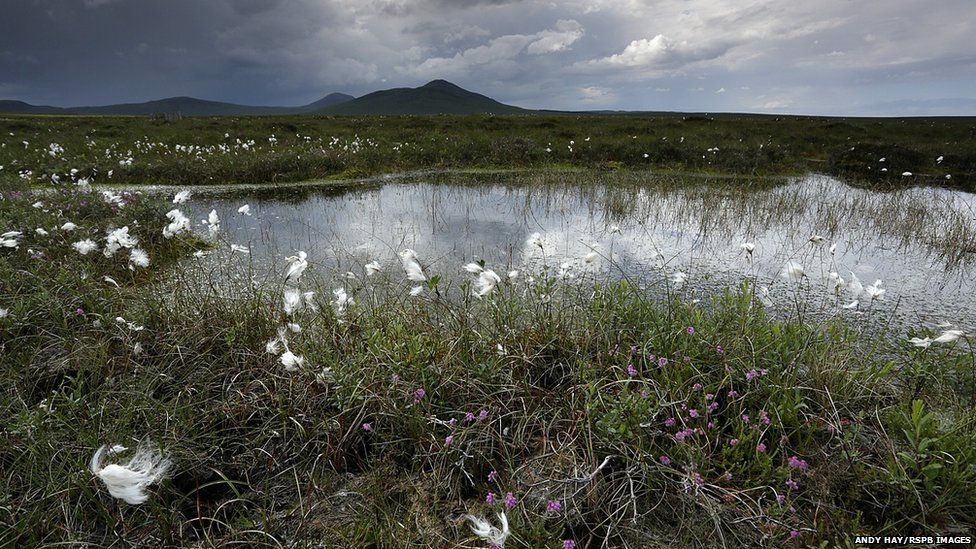UK Peatland Code designed to attract private funds
- Published

Private investors are being invited to help fund the restoration of about one half of the UK's peatlands.
The Peatland Code, say its developers, has been designed to link potential private funders with accredited restoration projects.
The habitat has been calculated to store three billion tonnes of carbon, more than 20 times the amount locked away in the UK's forests.
The code was launched at the World Forum on Natural Capital in Edinburgh.
The initiative has been developed by the IUCN UK Peatland Programme, which promotes the restoration of the UK's peatlands, and is overseen by a number of environmental bodies including: Scottish Wildlife Trust, the RSPB, the John Muir Trust and the Yorkshire Wildlife Trust.
"Peatlands are arguably the UK's greatest reserve of natural capital," said Peatland Code Chairman Paul Vaight.
Speaking at the code's launch, Mr Vaight said that the majority of the nation's peatland habitat were in a poor state of repair.
However, he added that they were relatively cheap and easy to restore. Once the dominant vegetation, sphagnum moss, had returned, the peatland began absorbing carbon once again.
"Not only that but a healthy bog acts as an excellent filter for water. This is very important in the UK since about 75% of our water catchment is in peatland areas," he observed.
"It also acts as a break on flash floods, delays water run-off and reduces the scale of water in the rivers."
Peatlands account for about 10% of the UK's land area and stores about three billion tonnes of carbon, more than 20 times the volume stored by the nation's forests.
The code is based on research carried out by teams from Birmingham City and Leeds universities.
Prof Mark Reed, who led the research team at Birmingham City University, said: "Whilst providing valued homes for some of our rare and endangered wildlife, our peatlands act as a huge store of carbon, locking up as half as much as half that found in the Amazon rainforest despite being a hundredth of its size."
International Union for Conservation of Nature (IUCN) UK Peatland Programme director Clifton Bain said the new code provided an opportunity for business leaders to show that they were serious about protecting the UK's natural capital.
The code, its developers say, firstly quantifies the carbon savings made as a result of restoring a peatland. It secondly gives those providing the funds confidence the carbon savings will be made, and deliver wider benefits to the area's wildlife and communities.
Natural standards
The World Forum on Natural Capital also saw the launch of a consultation on a framework that would standardise the way business measure its impacts and dependencies on natural capital.
The Natural Capital Protocol, developed by the Natural Capital Coalition, plans to create a system that allows the value of natural assets into organisations' decision-making processes.
The consultation runs until the end of February 2016, with the first version of the protocol being launched in the summer of 2016.
To date, there are an array of systems to measure and place a financial value on natural capital.
One such system has been developed by US-based organisation Aecom.
"I am an environmental economist and we have these economic notions of capital, such as financial capital and manufactured capital. These are common parlance within business," explained Aecom's Chris White.
"Then you have concepts such as sustainability and CSR (corporate social responsibility), which is generally seen as a separate area and is not viewed as a main issue within the boardroom.
"The idea of a natural capital approach is to try and bring them together. It is to talk about and view the environment as an asset. The idea is that you have a piece of natural capital like a forest and it provides something that is of value to a business over time," Mr White told BBC News.
Legacy sites
One company to have worked with Aecom's natural capital valuation system is National Grid.
"We have more than 600 legacy sites, which are things like gas holder sites and industrial sites that we have inherited from previous activities," explained Stuart Bailey, National Grid's head of sustainability and climate change.
"What we do with these is of interest to us and to our board," he told BBC News. "What we do and what we build has an impact on communities and they have an impact on the environment."
He explained that the challenge within National Grid was establishing a way to convert the environmental costs and benefits of these legacy sites into a "monetary value that our finance people and stakeholders understood".
Using the system developed by Aecom, Mr Bailey said it was possible to get natural capital onto the company's decision-making process.
He used the "negative asset" of an old gas holder site in Burnley, Lancashire, as an example.
"There is no commercial value to that piece of land. Gas holder sites in London have brownfield redevelopment value but in Burnley there is not the demand and it is actually a liability for us.
"We have problems with that site. We have problems with trespass and we have problems with fly tipping.
He explained that a consultation with the local community revealed that residents wanted an open green space that could be used for recreation.
"We have worked with the local authority and the forestry commission on a plan for a community woodland.
"This particular project is not costing us anything to do. It is a site that goes from a value of near zero to a site (using the tool developed by Aecom) with a value of £300,000.
Mr Bailey added: "We also get a few benefits, such as hopefully remove the fly-tipping issue, we get the security sorted and, hopefully, the local community gets some benefits too."
- Published24 November 2015
- Published11 June 2015
- Published28 August 2015
- Published27 January 2015
- Published16 June 2015
- Published21 March 2012